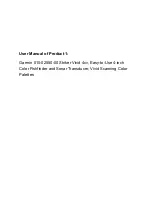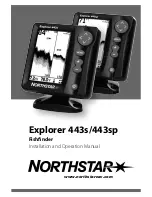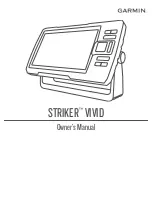
1-8
HD Series Fishfinders
Th
e h
sb2 Sy
st
em
The
hsb
2
System
The
hsb
2
(High Speed Bus) connection enables transfer of data among
compatible units. For example, fishfinder data is transferred from the master
display via the
hsb
2
connection and can be displayed
and controlled
on any
other
hsb
2
Plus Series LCD or CRT display (the repeater
display). However, if
you change a setting (for example:
DEPTH RANGE
) on one display, it affects all
displays showing fishfinder or fishfinder/chart overlay.
In particular, you connect the DSM250 Digital Sounder Module to the L770D/
RC Plus or L1260D/RC Plus Fishfinder over the
hsb
2
port. In addition, you can
connect your Fishfinder to a remote
hsb
2
Series Pathfinder Plus Radar and then
to a remote
hsb
2
Series Plus Chartplotter to provide fishfinder, chart, and radar
functionality on all three displays.
Full functionality of the fishfinder is achieved when it is part of an integrated
system, with other equipment (in addition to other
hsb
2
Plus units) connected
via SeaTalk or NMEA 0183. Data from this equipment including position and
heading is displayed on the display and is used in calculations.
It is possible to connect up to ten
hsb
2
Plus Series LCD or CRT displays to
provide an integrated system. Earlier HSB (non-Plus) Display units can be
upgraded to provide
hsb
2
compatibility. See
Connecting hsb2 Plus Series Units
on
page 2-26
for details.
Note:
Please contact Raymarine Customer Service or your authorized Ray-
marine dealer about upgrading your existing HSB (non-Plus) display units to
provide full
hsb
2
Plus functionality.
The
hsb
2
system can include several chartplotter displays, each with two chart
cartridge slots. Each display can access two local and up to six remote chart
cartridges. Charts can be controlled
independently
on each display, even when
a remote chart cartridge is being used. Details on connecting the equipment
are given in
Chapter 2
.
1.2 The Fishfinder Display
When you first turn the display unit on and select Sonar mode, the scrolling
bottom graph is displayed. This is a graphical representation of the echoes
seen by the DSM250 and transmitted to the Fishfinder. As time passes, this
display scrolls from right to left and becomes a record of the echoes seen. A
typical display is shown in
Figure 1-3
.
The images at the right hand side of the display are the most recent echoes.
Some echoes indicate fish and others show the bottom. It can also indicate
bottom structures, such as a reef or shipwreck. The upper and lower depth
range limits are shown.
81213_1.book Page 8 Monday, March 17, 2003 1:14 PM
Содержание L1250DRC
Страница 1: ...HD Series Fishfinders Owner s Handbook Document number 81213_1 Date February 2003...
Страница 2: ......
Страница 8: ...viii HD Series Fishfinders...
Страница 16: ...xvi HD Series Fishfinders...
Страница 100: ...4 22 HD Series Fishfinders Position Offset...
Страница 130: ...5 30 HD Series Fishfinders Moving Around the Chart...
Страница 194: ...7 50 HD Series Fishfinders Review Your Passage Plan...
Страница 206: ...8 12 HD Series Fishfinders Data Log Mode...
Страница 218: ...9 12 HD Series Fishfinders Worldwide Support...
Страница 234: ...C 6 HD Series Fishfinders Appendix C C MAP Chart Card Features...
Страница 246: ...viii HD Series Fishfinders...

































